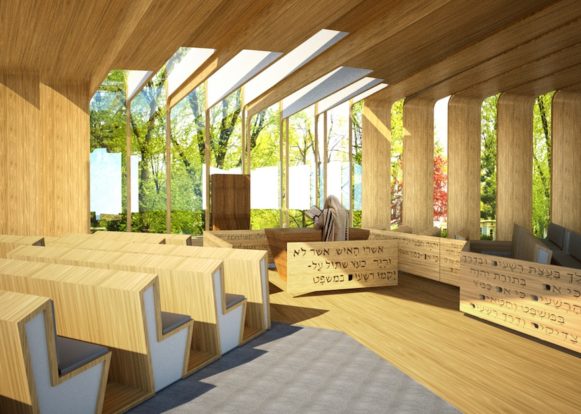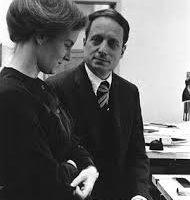Lilith Feature
Revising Our Ideas about Collective Inspiration
A growing body of recent research shows that creativity is not necessarily the domain of autonomous individuals. Rather than an inner activity done in solitude, it has been found that people often discover their thoughts and ideas through interactions with others. I first encountered this research when I tried to apply psychoanalytic ideas of creativity to my architectural design experience. Traditional psychoanalytic literature views art as sublimation, a process in which the artist’s inner unconscious and erotic forces are converted into a socially acceptable expression in the artistic product. But this description misses what for me is the most pleasurable part of design, and that’s the shared creative experience. I cherish those moments when everyday boundaries between me and my design collaborators get blurred, when who-said-what is no longer relevant or decipherable and innovative ideas emerge from interaction. The eminent child psychologist D.W. Winnicott spoke of this phenomenon when he suggested that the baby learns to experience her own emotions through the mirroring reflected by her mother. More recently, the relational approach to psychoanalysis shifted the focus from the mind of an individual patient, previously thought to exist “independently and autonomously within the boundaries of the individual,” to a model that sees the mind as inherently social, interactive and interpersonal. In the analytic session, therefore, the therapist pays close attention to subtle ways in which patient and analyst influence, reflect and affect one another. Jessica Benjamin, feminist theorist and psychoanalyst, uses the term “Third” to describe moments when two people join, recognize one another and have a shared experience that transcends the boundaries of each individual.
I find myself wondering about a resemblance of what I’m calling “relational creativity” to the centrality of community in Jewish practice. Torah study and prayer, the intellectual and spiritual religious focal points, are both traditionally preformed within a communal context. The concept of communal prayer may seem paradoxical. It suggests that personal introspection and the ability to experience deep yearning, pain or gratitude are enhanced by praying among others rather than in a contemplative solitude. I understand this as an awareness that the group context enables us to further discover ourselves. Similarly the hevruta, the yeshiva study couple, is the prototypical way of Jewish Torah learning suggesting that intellectual understanding is also enhanced when done in association with another.
I find this approach particularly useful to understanding architectural design, which is always a collaborative process. It is practiced within a firm, in conjunction with engineering consultants, it involves the participation of the clients and the problem-solving of the construction team. At times it might be aggressive and adversarial but more often great buildings emerge from a long and successful collaborative partnership. “Thus were the dancers set in motion,” writes Phyllis Lambert in her recent book, Building Seagram. It was a mutual dance involving her as the client, Mies Van Der Rohe as the architect and Philip Johnson, who designed the lighting, that gave birth to this New York City landmark skyscraper. The centrality of collaboration in architecture is often overlooked in a culture celebrating and branding “starchitects.” However, there are some who know better. Jeanne Gang, a rising talent in the field, included in her firm’s 2011 book a list of credits, much like one sees in the movies, naming everyone who worked on her office’s projects.
Keith Sawyer’s bestselling book Group Genius chronicles many examples, from jazz music to the development of the mountain bike, demonstrating that most inventions are the result of the eponymous “group genius.” Of course not all participants in collaborative work are equal. My relationship with my daughters, from whom I learn so much about myself and about parenting, can often feel very collaborative. Nevertheless, for us to feel safe it’s important that I remain in the role of parent and maintain the mother-child asymmetry. In an office, a collaborative team may have a clear, sole leader. But we now realize that partnerships of equals, where it is impossible to know where one person’s work ends and another’s begins, can also be successful models.
The Pritzker Prize, like other honors, follows a long tradition of rewarding individuals. But when the Pritzker wanted to nominate the Swiss firm of Jacques Herzog and Pierre de Meuron in 2001, they changed the rules to allow that partnership — of two men — to receive the prize jointly. Only this year, in response to the Denise Scott Brown petition, did the American Institute of Architects change its rule for the administration of its Gold Medal Award. In doing so, the A.I.A. announced that the historic change reflects “the changing nature of the practice that has become increasingly collaborative in nature.” (Did I mention that in 105 years no woman has received the A.I.A. Gold Medal Award?)
Collaboration isn’t only an aspect of the innovative team; society itself plays a central role in defining innovation, thereby actively participating in the creative process. Mihaly Csikszentmihalyi, in his book Flow, points out that genius and creativity are not objective achievements, but are measured and acknowledged within a specific cultural and historical context. D.S.B. is well aware of this. In an article called “Sexism and the Star System” (1989), she noted that definitions of star quality omit the “fact that stardom is something done to the star by others. Stars cannot create themselves.” When we are touched, excited and interested, it is our experience as viewers, users and critics, that makes art into art. In this context one might think about the role of social media. The public heard the call to acknowledge Denise Scott Brown along with Robert Venturi because of Facebook and change.org, tools that allowed thousands to participate in a cultural process that was traditionally reserved for a select group of jury members who author and authorize the historic record of great architects.
The pressure of social media notwithstanding, Lord Palombo, chair of the Prizker Prize, has refused to include D.S.B. retroactively in the 1991 award. While claiming to be aware that context plays a crucial part in awarding prizes, that prize criteria “may reflect cultural biases that underplay a woman’s role in the creative process,” he forgets that Pritzker Prizes are awarded to architects at a point in their careers that celebrates their past accomplishments while encouraging future growth. Palombo suggests that while “A later jury cannot re-open, or second guess the work of an earlier jury …Ms. Scott Brown remains eligible for the Pritzker Award.” Does he really mean next year? When D.S.B. will be 83 years old? Doesn’t he realize that her work has already received the prize?
In an oral history, Denise Scott Brown tells of a late-night conversation she had with a German rabbi in Sweden. To her question about what it means to be a Jew he answered, “It’s to have a prophetic mission.” D.S.B. added, “And that stayed with me… as a thought about ‘What does that mean professionally to have a prophetic mission?’ And that might be one of the reasons why my span is broad, why my concerns are to mix social and architectural questions.” It is this prophetic mission that reminds us that the Pritzker committee should undertake to assess its ongoing inclination toward the idea of individual genius. D.S.B. may not see her name entered beside Mr. Venturi’s in the Pritzker roll of honorees. But if the reverberations of this petition finally expose the complex, interconnected and co-created world in which we design and live, and move to an understanding of the relational nature of creativity, that will be its own prize.
Esther Sperber founded the award-winning New York-based firm Studio ST Architects in 2003. Born and raised in Jerusalem, she also lectures and writes on architecture and psychoanalysis.





